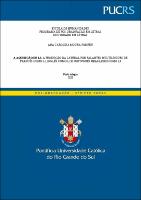| Share record |


|
Please use this identifier to cite or link to this item:
https://tede2.pucrs.br/tede2/handle/tede/11134Full metadata record
| DC Field | Value | Language |
|---|---|---|
| dc.creator | Pompeu, Ana Carolina Moura | - |
| dc.creator.Lattes | http://lattes.cnpq.br/4326633655713808 | por |
| dc.contributor.advisor1 | Brescancini, Cláudia Regina | - |
| dc.contributor.advisor1Lattes | http://lattes.cnpq.br/5437201413552987 | por |
| dc.contributor.advisor-co1 | Perna, Cristina Becker Lopes | - |
| dc.contributor.advisor-co1Lattes | http://lattes.cnpq.br/6405342131243110 | por |
| dc.date.accessioned | 2024-04-08T18:31:41Z | - |
| dc.date.issued | 2023-05-26 | - |
| dc.identifier.uri | https://tede2.pucrs.br/tede2/handle/tede/11134 | - |
| dc.description.resumo | O presente estudo investigou a produção da lateral pós-vocálica medial e final por falantes multilíngues de francês como L1, de inglês como L2 e de português brasileiro como L3. Fundamentam este estudo a Fonologia de Uso (BYBEE, 2001; 2002; 2010) e a Teoria dos Exemplares (PIERREHUMBERT, 2001, 2003, 2006), modelos que concebem o detalhe fonético e a gradiência como parte inerente às representações mentais dos falantes e consideram a experiência e o uso da língua como essenciais para a organização e para o gerenciamento do conhecimento linguístico. A investigação propôs o cálculo do índice de velarização da lateral a partir da fórmula [(F2-F1)+F3]norm, pautada na característica contínua de velarização da lateral sugerida por Recasens (2012). A partir das diferenças de índice de velarização da lateral que as três línguas, francês, inglês e português, apresentam em posição de coda medial e final, o objetivo da pesquisa foi realizar um estudo sociofonético da produção da lateral por falantes multilíngues, residentes em Porto Alegre/RS. Para a realização do trabalho contou-se com uma amostra de cinco participantes multilíngues e de três monolíngues, um para cada língua considerada. Os multilíngues participaram de seis instrumentos de produção, a saber: entrevista de experiência pessoal; nomeação de imagens, leitura de palavras em português, leitura de logatomas, leitura de palavras em inglês e leitura de palavras em francês. Cada monolíngue participou do instrumento de leitura de palavras relativo à sua língua materna. Todos os dados foram gravados através dos recursos da plataforma de videoconferência Zoom e tratados acusticamente por meio do software Praat, versão 6.1.50 (BOERSMA & WEENINK, 2021). A análise acústica da lateral na fala em francês como L1, em inglês como L2 e em PB como L3 dos multilíngues permitiu verificar a redução do índice de velarização da lateral na L2 e na L3 em relação ao da L1. A lateral produzida em francês como L1 apresentou índice de velarização maior do que o do inglês como L2, o qual apresentou índice de velarização maior ou igual ao do português brasileiro como L3 (francês-L1 > inglês-L2 ≥ PB-L3). Tal resultado, contrário à hipótese de que a lateral em francês como L1 apresentaria índice de velarização maior ou igual ao português brasileiro como L3, o qual apresentaria índice de velarização menor ou igual à lateral produzida em inglês como L2 (francês-L1 ≥ PB-L3 ≤ inglês-L2), evidencia a estabilidade do francês como L1 e a vulnerabilidade do inglês como L2 e do português brasileiro como L3. A análise dos condicionadores do índice de velarização da lateral no português brasileiro como L3 revelou que os fatores atuantes na redução do índice são as vogais precedentes [a] e [ɛ]; o contexto de sílaba tônica, a leitura de palavras em comparação à de logatomas e, por fim, os instrumentos em que a fala é menos controlada, a saber, entrevista de experiência pessoal e nomeação de imagens | por |
| dc.description.abstract | The present study investigated the production of medial and final postvocalic lateral by multilingual speakers of French as L1, English as L2 and Brazilian Portuguese as L3. This study is based on Usage Base Phonology (BYBEE, 2001; 2002; 2010) and Exemplar Theory (PIERREHUMBERT, 2001, 2003, 2006). The models conceive the phonetic detail and gradience as part of speakers’ mental representations. Experience and the use of the language are also considered as essential on the organization and on the management of linguistic knowledge. The investigation proposed the lateral darkness index from the formula [(F2- F1)+F3]norm, based on the lateral darkness continuous feature suggested by Recasens (2012). According to the differences in the lateral darkness index that French, English and Portuguese have in medial and final coda position, the objective of the research was to carry out a sociophonetic study on the production of the lateral by multilingual speakers, living in Porto Alegre/RS. The study consists of a sample of five multilingual and three monolingual participants, one for each language considered. Multilinguals took part in six production instruments, namely: personal experience interview; images naming, Portuguese word reading, nonwords reading, English word reading and French word reading. Each monolingual participated in the word reading instrument related to their mother tongue. All data were recorded using the resources of Zoom videoconferencing platform and treated acoustically using the Praat software, version 6.1.50 (BOERSMA & WEENINK, 2021). The acoustic analysis of the lateral in French as L1, in English as L2 and in BP as L3 of the multilinguals allowed us to verify the reduction of the lateral darkness index in L2 and in L3 in relation to that of L1. The lateral produced in French as L1 presented a higher darkness index than that of English as L2, which presented a darkness index higher than or equal to that of Brazilian Portuguese as L3 (French-L1 > English-L2 ≥ BP-L3). This result, contrary to the hypothesis that the lateral in French as L1 would present a darkness index higher than or equal to Brazilian Portuguese as L3, which would present a darkness index lower than or equal to the lateral produced in English as L2 (French-L1 ≥ PB- L3 ≤ English-L2), shows the stability of French as L1 and the vulnerability of English as L2 and Brazilian Portuguese as L3. The analysis of the conditioners of lateral darkness index in Brazilian Portuguese as L3 revealed that the factors acting in the reduction of the index are the preceding vowels [a] and [ɛ]; the stressed syllables context, the words reading compared to nonword and, finally, the less controlled speech, obtained through interviews of personal experience and images naming | eng |
| dc.description.provenance | Submitted by PPG Letras ([email protected]) on 2024-03-05T21:05:57Z No. of bitstreams: 1 TESE VERSAO DEFINITIVA-AnaCarolinaPompeu.pdf: 3327947 bytes, checksum: a4c97b74185da2e0dbb9327a30f9588c (MD5) | eng |
| dc.description.provenance | Approved for entry into archive by Sarajane Pan ([email protected]) on 2024-04-08T18:19:50Z (GMT) No. of bitstreams: 1 TESE VERSAO DEFINITIVA-AnaCarolinaPompeu.pdf: 3327947 bytes, checksum: a4c97b74185da2e0dbb9327a30f9588c (MD5) | eng |
| dc.description.provenance | Made available in DSpace on 2024-04-08T18:31:41Z (GMT). No. of bitstreams: 1 TESE VERSAO DEFINITIVA-AnaCarolinaPompeu.pdf: 3327947 bytes, checksum: a4c97b74185da2e0dbb9327a30f9588c (MD5) Previous issue date: 2023-05-26 | eng |
| dc.description.sponsorship | Coordenação de Aperfeiçoamento de Pessoal de Nível Superior - CAPES | por |
| dc.format | application/pdf | * |
| dc.thumbnail.url | https://tede2.pucrs.br/tede2/retrieve/190117/TES_ANA_CAROLINA_MOURA_POMPEU_CONFIDENCIAL.pdf.jpg | * |
| dc.thumbnail.url | https://tede2.pucrs.br/tede2/retrieve/192270/TES_ANA_CAROLINA_MOURA_POMPEU_COMPLETO.pdf.jpg | * |
| dc.language | por | por |
| dc.publisher | Pontifícia Universidade Católica do Rio Grande do Sul | por |
| dc.publisher.department | Escola de Humanidades | por |
| dc.publisher.country | Brasil | por |
| dc.publisher.initials | PUCRS | por |
| dc.publisher.program | Programa de Pós-Graduação em Letras | por |
| dc.rights | Acesso Aberto | por |
| dc.subject | Aquisição de L3 | por |
| dc.subject | Consoante Lateral | por |
| dc.subject | Multilinguismo | por |
| dc.subject | Índice de Velarização da Lateral | por |
| dc.subject | Produção da Fala | por |
| dc.subject | L3 Acquisition | eng |
| dc.subject | Lateral | eng |
| dc.subject | Multilingualism | eng |
| dc.subject | Lateral Darkness Index | eng |
| dc.subject | Speech Production | eng |
| dc.subject.cnpq | LINGUISTICA, LETRAS E ARTES::LETRAS | por |
| dc.title | A aquisição de L3 : a produção da lateral por falantes multilíngues de francês como L1, inglês como L2 e português brasileiro como L3 | por |
| dc.type | Tese | por |
| dc.restricao.situacao | Trabalho será publicado como artigo ou livro | por |
| dc.restricao.prazo | 06 meses | por |
| dc.restricao.dataliberacao | 08/11/2024 | por |
| Appears in Collections: | Programa de Pós-Graduação em Letras | |
Files in This Item:
| File | Description | Size | Format | |
|---|---|---|---|---|
| TES_ANA_CAROLINA_MOURA_POMPEU_COMPLETO.pdf | ANA_CAROLINA_MOURA_POMPEU_TES | 3.25 MB | Adobe PDF |  Download/Open Preview |
Items in DSpace are protected by copyright, with all rights reserved, unless otherwise indicated.




